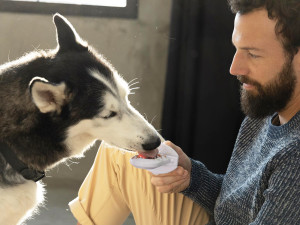Does Your Pet Need Therapy?
Dogs and cats can’t read self-help books, so a veterinary behaviorist explains how your pet may benefit from being in treatment.

Share Article
In recent years, there have been many much-needed cultural conversations about mental health. People have become more aware of their emotional needs and actively seek ways to manage stress, anxiety, depression, and other mental health challenges — which is a great thing. But the question remains: What about our pets? Do they deal with similar concerns, and how can we help them if they do?
Some pets live with anxiety or fear. Some have compulsive disorders, such as constant licking, pacing, or chasing imaginary objects. Others exhibit behaviors that may be perfectly normal for them (like barkingopens in a new tab, scratching furniture, or chewingopens in a new tab) but drive their humans up the wall. In all of these instances, behavioral therapy can help make the home a happier place for pets and their humans. To get the scoop on how a behavior treatment plan might help your pet, we talked to a board-certified veterinary behaviorist, Dr. Kat Pankratz.

Get (totally free) deals for food, treats, accessories, tech, and way more pet parenting must-haves.
opens in a new tabTypes of Behavioral Support
The first thing to understand is that, much like humans, every pet is different. Their behaviors may appear common, but the severity and underlying causes vary. A skilled professional can assess your pet and provide tools and resources to address the challenges at hand. When choosing a professional, the options range from trainers to general practice veterinarians to veterinary specialists. All can provide helpful support, though their education, skillsets, and capabilities differ. Dr. Pankratz breaks down the distinctions.
“A board-certified veterinary behaviorist (Diplomat of the American College of Veterinary Behaviorists or DACVB, or veterinary behaviorist) is a veterinarian who underwent additional years of training, board examination with certification, and continues to maintain current knowledge of the scientific understanding of all aspects of animal behavior,” explains Dr. Pankratz. “Veterinary behaviorists have the skills to assess the pet as a whole: physically and mentally. We can diagnose behavior conditions and formulate a comprehensive treatment plan.”
“A general practitioner veterinarian can also diagnose and create a treatment plan,” she continues. “The extent of their ability to diagnose and formulate a behavior treatment plan varies depending on the individual veterinarian’s comfort with behavioral medicine. Although their understanding of animal behavior may not have the depth or breadth of a DACVB, a general practitioner interested in behavior can be an important start.”
“The general titles trainer and behaviorist have no restrictions for their use. Certified trainers have undergone some education or training to receive one of several certifications. Though there are exceptions, many trainers that focus on obedience training may not have sufficient skills to support the emotional change needed to treat behavioral problems. Trainers should not diagnose and cannot prescribe therapeutics that require a prescription. However, they can provide a helpful perspective to guide pet owners to seek veterinary support if they suspect the pet might benefit from a medical evaluation or possibly a therapeutic prescription.”
Managing Nuisance Behaviors
Digging holes in the backyard, clawing your couch cushions, and jumping up on house guestsopens in a new tab are a few examples of behaviors that your pet probably loves (and for them come naturally) but that you could do without. The fact that these actions bum you out is reason enough to address them. But sometimes, these behaviors can also affect a pet’s quality of life.
“Any behavior that reaches a point where it impacts a pet’s ability to eat, drink, rest, or engage in enjoyable activities could be a sign of something more pathologic,” Dr. Pankratz says. “In situations like that, seeking trusted professional advice would be recommended.”
Regardless of whether it’s normal behavior or a pathologic condition, a trained professional can help. It may be a matter of changing up your pet’s environment or exercise routine to ensure their needs are being met. Or, your pet may have an underlying medical issue that requires diagnosis and treatment. In either instance, addressing the problems will make home life happier for you and your pet.
Potential Treatment Plans for Anxious, Fearful, or Aggressive Pets
Some of the most challenging issues to address manifest as anxiety, aggression, or fear. We don’t always know what types of trauma or stress our pets have faced, but that doesn’t mean we can’t find ways to help. As noted earlier, a veterinary behaviorist has the most tools in the toolbox to address a pet’s physical and emotional needs. According to Dr. Pankratz, a veterinary behaviorist’s treatment plan may incorporate components of environmental management, behavior modification, and therapeutics.
Environmental management
In your own life, you probably go out of your way to avoid things that trigger you. Environmental management is all about helping your pet do the same.
“This part of a treatment plan focuses on adjusting the environment for the pet to meet their physical and mental needs,” Dr. Pankratz says. “Modifying the environment aims to decrease exposure to stimuli that cause negative emotional states for the pet. Avoiding that stimuli helps maintain safety and prevents the pet from repeating unwanted behaviors. The goal is to set the pet up to success, so there is little opportunity to perform the unwanted behaviors, or be placed in a circumstance that might cause negative emotions.”
Behavior modification
Do you ever take deep breaths when you need to calm down? Or ease into situations that you know you’ll find stressful? As humans, when we can’t avoid the things that bother us, we have to learn how to cope with them. It’s the same for pets, and behavior modification can help.
“Behavior modification focuses on adjusting a pet’s emotional state,” Dr. Pankratz says. “The primary focuses include changing a pet’s emotional state from negative to positive and helping them develop coping skills to navigate difficult situations. This style of training is different from obedience training, as it focuses on empowering the pet to learn how to feel differently. This often starts in an environment that is very comfortable for the pet. When that pet has built sufficient foundational learning, we build on those skills thoughtfully and systematically in constructed learning opportunities that gradually build in difficulty based on that individual pet’s progress.”
Therapeutics
Is there a pill for that? Yes, sometimes there is.
“Therapeutics vary from over-the-counter products to prescriptions,” Dr. Pankratz says. “The intent is to help dial down the intensity of negative emotions. Although sometimes the response can be incredible, therapeutics by themselves often do not eliminate the negative emotions altogether (thus the importance of the other two parts of the treatment plan). The goals of therapeutics are to decrease the negative emotions enough so the pet can better learn what is being taught instead of quickly escalating over-threshold, or to assist in a faster recovery after a triggering event. The goal of therapeutics should rarely be to sedate the pet or change their personality.”
What You Can Do as a Pet Parent
You’ve already completed step one: research ways to help your pet through behavioral challenges.
The next best thing you can do is be a diligent observer and scribe. That means paying close attention to your pet’s behavior and what is going on around them when the behaviors occur. It’s also important to keep notes on recent changes in your pet’s life. Did you put them on a new medication? Get a new pet? Move to another home? Any information you can provide to the team of people supporting you will help them create the most effective treatment plan for your pet.

Kate Sheofsky
Kate Sheofsky hails from San Francisco, where she developed a love of writing, Giants baseball, and houses she can’t afford. She currently lives in Portland, OR, and works as a freelance writer and content strategist. When not typing away on her laptop, she enjoys tooling around the city with her two rescue pups searching for tasty food and sunny patios.
Related articles
![Young ginger haired woman sitting cross legged on the floor in her living room while meditating with her white dog seated on a pillow next to her]() opens in a new tab
opens in a new tabTai Chi Practices Help With Dog Handling
Using this mind-body exercise can provide a beneficial lesson on how to handle dogs.
![A woman holding a cat close to her while sitting on a yoga mat.]() opens in a new tab
opens in a new tabShockingly, Your Pet Will Enhance Your Mindfulness Practice
The next time they try to kiss your face while you’re in corpse pose, let them.
![Two Black women with curly hair laying on the grass with their senior dog laying between them]() opens in a new tab
opens in a new tabTherapy Dogs Can Help You With Your ADHD
Happy news: Pups can help support your (or your kid’s) everyday needs.
![Woman in striped dress shirt using an acupuncture needle on a senior Chihuahua dog]() opens in a new tab
opens in a new tabCan Dogs Get Acupuncture?
Find out if this complementary and alternative medicine is right for your pup.
![Senior mixed breed dog playing with washable snuffle rug for hiding dried treats]() opens in a new tab
opens in a new tabHow to Help Your Bored Senior Dog Spice Up Their Life
Spice Girls reference aside, just because your dog is graying around the eyes doesn’t mean those eyes don’t light up at playtime.
![A vet holding medicine near a dogs face]() opens in a new tab
opens in a new tabHow to Find a Veterinary Specialist
Just like your doctor would refer to you a specialist for expert care for a complicated issue, your vet may do the same for your dog.











